

We’ve known each other for a while now, dogs. For the last few years, you’ve lived in my house, slept on my bed, and peed on almost every inch of my yard. And unless you successfully run away or die, you’ll likely continue to coexist with me for the rest of your lives. That being the case, there are some things I think you should know. Most of these things are very basic and shouldn’t even have to be explained, but you guys have displayed an alarming lack of common sense, so here we go.

Through observation and my daily interactions with you, I have noticed a few particularly troublesome things about your worldview. I don’t know how or why these misconceptions originated, but it’s time you know the truth.
You’re wrong about holes. Holes are hardly ever important, especially not the ones you make. Have you ever paused while digging a hole and wondered, What is the purpose of this? What does this hole actually mean in the grand scheme of things? Would my life be any different if I wasn’t doing this? Even if you can’t figure out why you’re doing it, surely you know from experience that it’s going to end with you shamefully hiding under the table so I won’t see all the guilt and dirt on your face. That isn’t a fun situation for anybody.
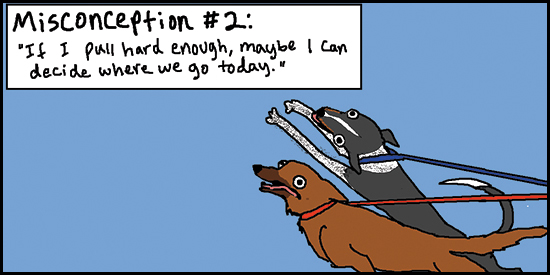
I can understand wanting to try this out. I can understand thinking, Hmm . . . maybe this will do something and experimenting a little. But for the past three years, you’ve spent the entire duration of every walk strangling yourselves on the off chance that maybe this time it will work. It’s never going to work, dogs. No matter how hard you pull, it’s never going to make me think, “You know what? Maybe it would be sort of fun to walk in the middle of the street with all the cars . . . and maybe I do want to go splashing around in the duck pond in the middle of December.”
You aren’t allowed to decide because you are really bad at making decisions. And you have to wear a leash because you don’t know that you are bad at making decisions. You would make too many of them if the leash didn’t stop you.
For example, say we are walking to the park. Everything is going as planned until you see this on the other side of the road:
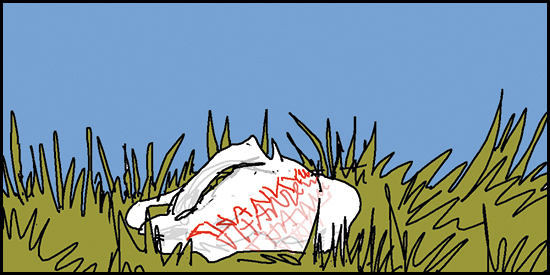
Panic sets in.
If you were not tethered to me by your leashes, you would be able to make too many decisions about how to react.
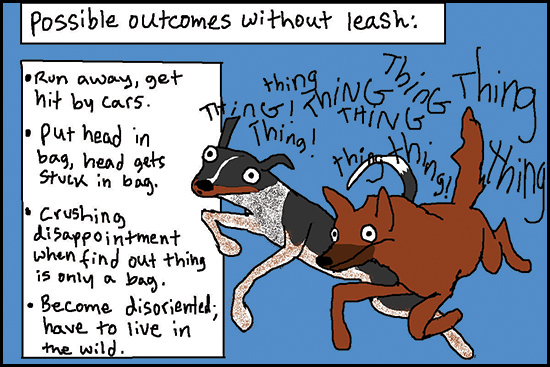
But when you are attached to a leash, you are protected from yourselves.
So no, pulling on your leashes isn’t going to make me change my mind about anything. I am fully aware of what would happen if you were allowed to make your own decisions, and that’s why you aren’t allowed to make them.
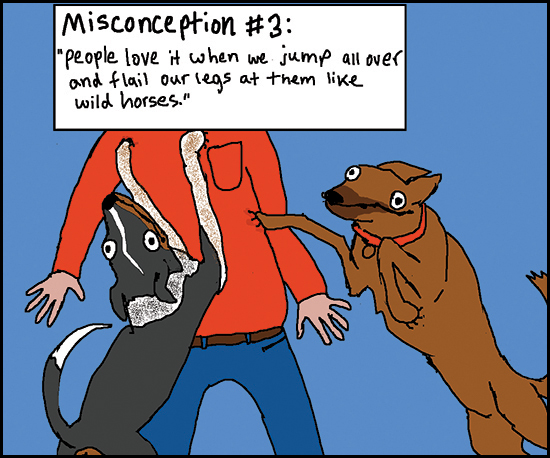
What are you trying to accomplish by doing this? It doesn’t make any sense. When I encounter someone I haven’t seen in a while, I have never once thought, I should jump at them and poke their face with my fingers and keep doing that until someone locks me in the bathroom. Because that’s insane. What would you think if I did that to your dog friends?
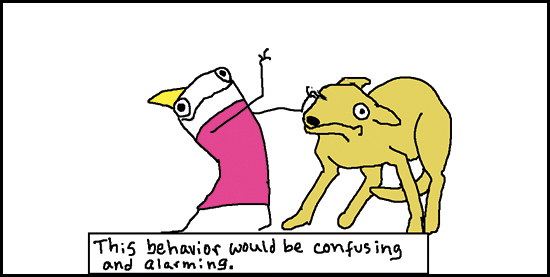
Nobody likes this. But you can’t seem to believe that.
Tell me, dogs, while you are being pushed away and kneed in the chest, and everyone is collectively shouting at you, “NO! OFF! BAD DOG”—what convinces you that we’re enjoying ourselves?
Or perhaps you do understand that everyone hates what you are doing, but you think we haven’t tried it enough to be sure that we hate it . . .
I assure you, we’ve all experienced more than enough poking to determine that we hate it.
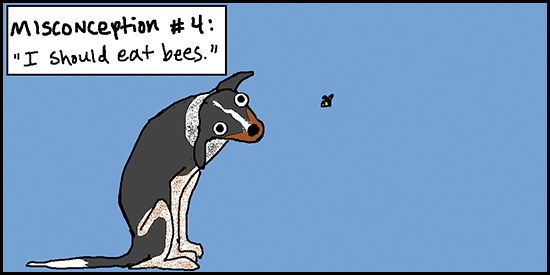
I didn’t think that this would need to be explained. Eating bees is sort of its own consequence. But you keep doing it. Haven’t you noticed that every time you try to eat bees, you get stung on the face? No matter how many times you eat bees, the outcome is always going to be the same.
The outcome will never be different.

It really won’t be different ever.
The only proper way to react to bees is to leave them alone. In case the distinction isn’t clear, leaving bees alone does not include eating them.
After reading this chapter, you may be wondering, “Why do we believe so many things that are wrong?” And I think the answer may have something to do with how you form your conclusions in the first place.
This logic is flawed for a number of reasons, but the important lesson to take away from this chapter is that you have absolutely no idea what you’re doing. Even if you really feel like you do, you don’t. The fundamental structure of your reasoning is all kinds of fucked up, so you’ll need to find some other way to figure out what things to do and what things not to do . . .

You’re probably thinking, “Hey, I know what that word does!” But remember what we just talked about. Most of the things you know are wrong, and your definition of this word is no exception. The first thing you may be surprised to learn is that the word “no” has only one definition when I am shouting it at you. The ONLY thing the word “no” means is “Stop doing that, I hate it.” That’s the only thing it will ever mean.
To be clear, this means that the word “no” DOES NOT mean any of the following things:
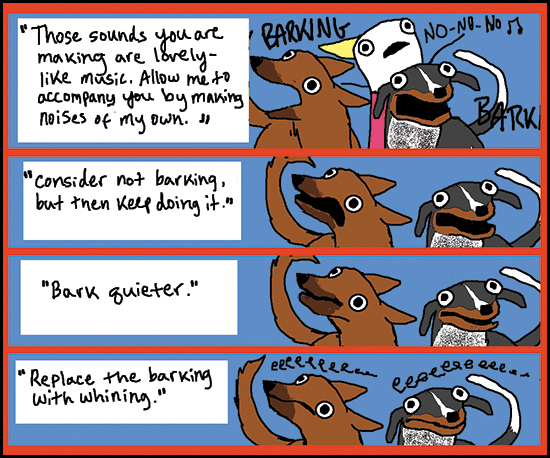
I’m sure you’re thinking, Oh, yes, that word. We know it. We always are knowing it. But just to be sure, here’s a little pop quiz. It’s tricky, so don’t get discouraged:
It’s ten o’clock at night. The TV is emitting a sound that you don’t immediately recognize. Confused, you begin barking and clawing at the door. You then hear me shout the word “no” at you. What am I trying to tell you?
A. Keep going! You’re doing a great job!
B. Make a different sound.
C. I know you’re busy, but when you find the time, could you knock everything off the table?
D. Hey, listen! I want to say one of the words I know!
E. Stop doing that, I hate it.
Answer: E. Stop doing that, I hate it.
Hopefully you were not surprised by that answer.

Noises are happening! What is the solution??
Relax, dogs. I’m going to tell you soon. But first, let’s talk about your current plan for dealing with unfamiliar noises.
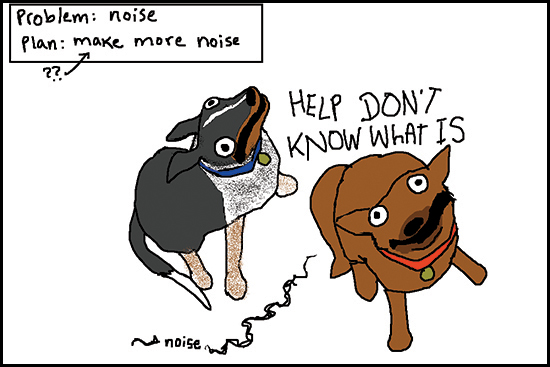
Are you trying to cover up the unfamiliar sound with a louder sound so it can’t confuse you anymore? Are you trying to scare it? Do you even know why you are doing this?
Making more noise isn’t a solution for noise. It’s just making more noise on top of the noise. And before you ask: no, making even more noises to cover up the noises your friend is making isn’t a solution either. This is how infinite loops are created.
A better plan for dealing with noises would be something like this:
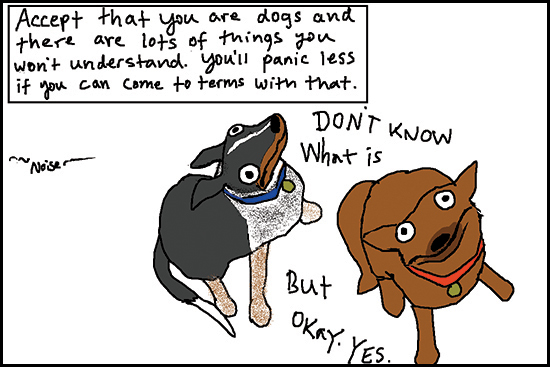
Now that you don’t have to worry about noises anymore, you’ll have more time to worry about the things you actually should be worrying about!

Simple dog, this one is directed mostly at you. It’s tough to know where to start because, to be completely honest, I’m not sure what your rules are for deciding something is scary or not.
What I CAN tell you is that almost none of the things you’re scared of are actually harmful, and many of the things you aren’t scared of are deadly.
The following list is incomplete (it is not possible for me to discuss every object in the world individually), but it should give you a good starting point:
Nail clippers: As you may have noticed, trimming your nails is a traumatic event that requires three people, a beach towel, and a can of spray cheese. But why? Why does it have to be like this? I’m not sure what you think we are trying to do to you, but I promise it isn’t whatever you think it is. Because whatever you think it is must be horrifying. That’s the only way to justify how traumatic this event seems to be for you. What’s really going on is that we are trying to make your nails shorter so that when you jump up and flail your legs at people or start sprinting around on the wood floors for absolutely no reason, the damage you can do is minimized.
Horse statue: I know, I know—it looks like a horse. But it isn’t. Statues are tricky like that. It’s too complicated to explain why the horse statue exists, so you’ll just have to trust me that it isn’t a real horse and it can’t hurt you. I promise I wouldn’t lie to you.
Lawn mower: The lawn mower is surprisingly dangerous. Yes, it makes a fun little noise and it hasn’t actually done anything dangerous to you yet, but that’s because I lock you in the house before turning it on. Because I can see the future and I know what will happen if I let you play with the lawn mower.
Vacuum: Despite being almost exactly the same thing as a lawn mower, the vacuum is not dangerous. Because unlike lawn mowers, vacuums are completely unable to turn your legs into hamburger meat. It’s weird that you’re so scared of the vacuum and so trusting of the lawn mower.
Balloons: Remember when you and I took that road trip together and we stopped to go for a jog in Ritzville, Washington? And it was sort of fun because it was Halloween and there were all sorts of scary decorations to look at? And somehow, out of all the decorations we ran past—all the skeletons and giant spiders and flashing, screaming, motorized corpses—somehow a fucking balloon was the thing that made you yank me into the street as you fled in terror? Why did that happen? It was just floating there harmlessly, tied to a tree branch twenty feet away. I’m going to tell you a secret about balloons: they are mostly air. The scary thing is just an act.

You’re really bad at making up games, dogs. From what I can tell, most of the things you consider fun involve ruining something or doing the same thing so many times in a row that everyone except you hates it.
You seem to derive a great amount of joy from forcefully influencing the shape of things. Does this activity make you feel powerful? Is this how you satisfy your urge to make decisions? I’m sure it’s a great feeling to decide that the basket shouldn’t be a basket anymore and then actually be able to make that happen because the basket can’t stop you. But there are less destructive ways to make decisions.
For example, here’s another game involving decisions:
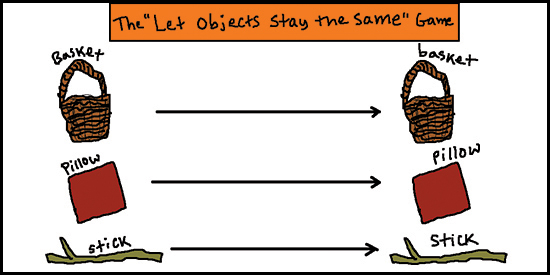
If you decide NOT to destroy objects, you are still making decisions! This might seem like a boring game, but I promise, if you just allow yourselves to be filled with wonder at how extremely the same everything stays, you’ll have fun. I know you very well. You are some of the most easily entertained creatures on the planet.
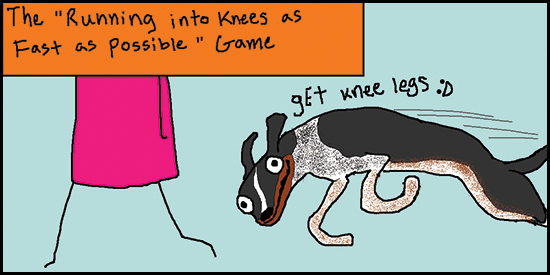
This is probably your worst game, dogs. I hate this game. From what I can tell, there are two main variants of it: running into knees with your face, and running very close to knees while holding a huge stick in your big, dumb mouth.
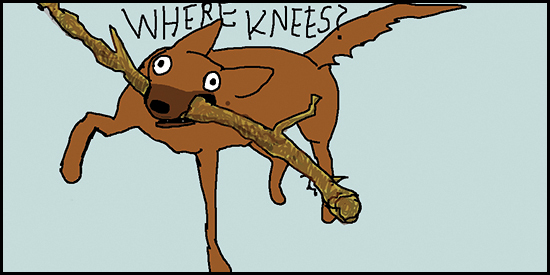
Nobody wants to play this game except you. Not even the old lady at the dog park. Not even children.
Instead of playing this game, why not play “Run Around and See How Far Away from Knees I Can Be”?
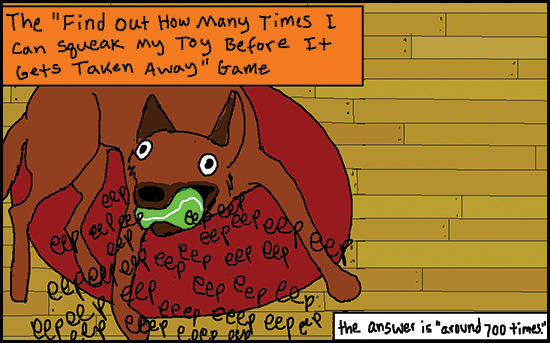
Lying on the floor and squeaking your toy for three hours in a row isn’t technically a game, but you seem to think it is, and that’s why you can’t have squeaky toys anymore.
The important lesson here is to practice moderation in everything you do, including squeaking your squeaky toys. If you feel like doing something a lot, do it about a tenth of that amount instead.
It’s unclear how you win or whether winning is even something you’re trying to do, but this game needs to stop.

By now, I’m sure you can see that most of the things you want are stupid and most of the decisions you make are bad. Because of this, things aren’t going to go your way very often. You need to be comfortable with disappointment.
If I have made a decision that is different from what you want, making high-pitched sounds at me will not change my mind.
Neither will pawing at my legs.
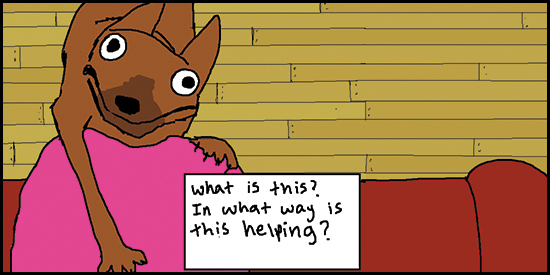
And finally, you cannot trick me. I know that T-shirts do not spontaneously fly apart into pieces. And I’m especially not going to believe that the T-shirt was destroyed by forces beyond your control when you’ve still got pieces of it stuck to your face.
Pretending that I haven’t fed you immediately after I fed you isn’t going to work either.
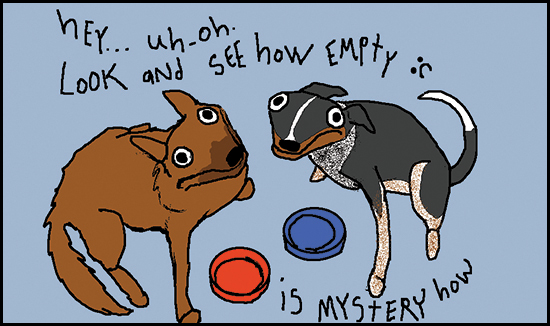
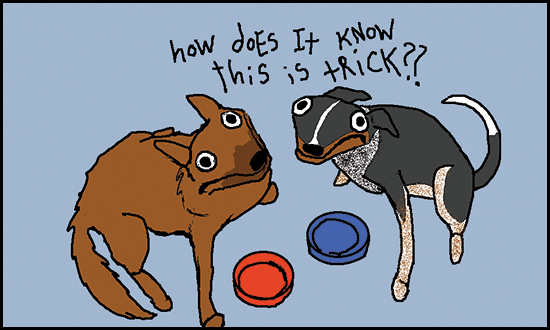
I know that you’ve already eaten because I am the one who gave the food to you. I remember doing it.
Also, I’m never going to believe that all four of your legs stopped working at the exact moment I decided we should leave the dog park.
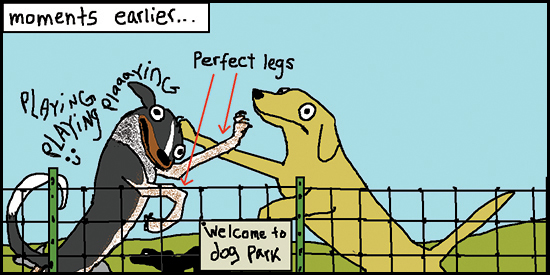
You think you’re being so sneaky. I’ll admit that it’s embarrassing when I have to drag you to the car by your perfectly functional legs, past all the people who are judging me because none of their dogs become situationally quadriplegic and they’ve never experienced this so they don’t know what’s going on. But I do. I know exactly what’s going on. This same thing happens every single time I try to leave the dog park with you, and I’m not just going to stay there forever because other people might judge me for dragging you.
But you thought that’s what would happen, didn’t you. You thought I would allow you to become some sort of dog-park-dwelling legless creature. Tell me, dog, what’s the point of living at the dog park if you’re just going to lie on the ground pretending to be paralyzed so you don’t have to go home? How would you find food? What would you do when it rained?
This is why you need me.

Okay, dogs, I’m sure you’ve got some questions after all of that. Fortunately, I know exactly what those questions are because you’re pretty transparent when you don’t understand something.
Q: Should eat bees?
A: No.
Q: But . . . never bees?
A: No. You should never eat bees.
A: No.
Q: But how does it not eat bees?
A: When you see a bee, you can avoid eating it by not putting it into your mouth. If you want to be extra sure that you will not eat bees, go somewhere where there are no bees until the urge to eat bees passes.
Q: Why does bad decision?
A: That’s a good question, dogs. Unfortunately, I don’t know why you make bad decisions. It’s just something you do.
Q: How doors?
A: If I told you how doors work, you’d be able to make too many decisions.
Q: No.
A: That isn’t a question.
Q: Whole time was bag?
A: Yes, in Chapter 1, Misconception #2, the object in the example was a bag the entire time. That wasn’t supposed to be a trick.
Q: How does tricking?
A: Before you can understand how tricking works, you need to understand the concept of subtlety.
Q: Sorry.
A: That is not a question, but I accept your apologies.